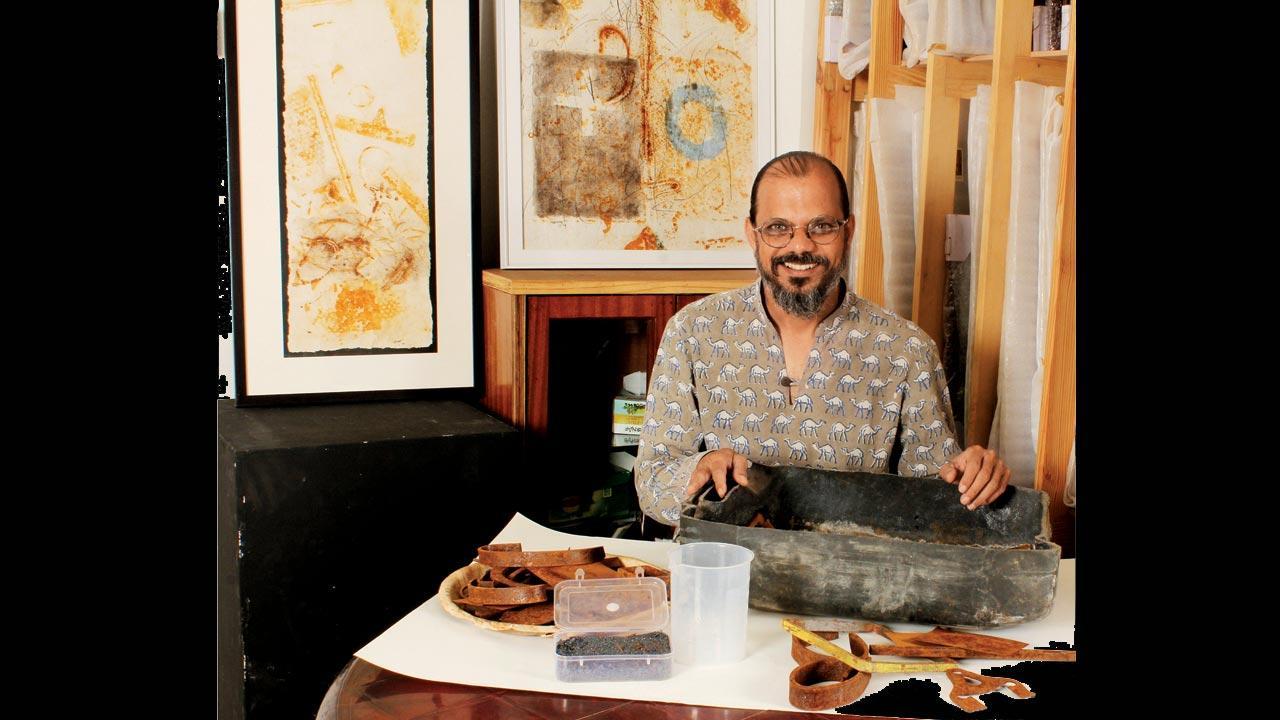A visual artist’s 150-odd works created from the residue of scrap during the lockdown gloom, imbue life into colours of corrosion

Vikram Marathe, 50, seen experimenting with iron objects and other scrap material at his studio in Pune
Vikram Marathe places iron objects—a nail, a junked diya, a door knob —on wet paper. The rust colours come on to the surface. They have a connection with the image in the painter’s mind, and often, they extend to unknown frontiers. The artist consciously avoids application of external water-based or acrylic paint on paper, but lets the rust assume surprising shapes.
ADVERTISEMENT
In his recent Lockdown Faces series, the rust residue on paper gave birth to visages that resembled the Punekars whom he had chanced upon during the curfew. But, one of them stood out as the bespectacled song writer-peace activist John Lennon, who resides in Marathe’s consciousness. The faces in the series came to life with the red, blue and black carbon traced on paper. But, essentially it was a play with the residual brown. Marathe banked on shades from flakes and corrosive scrap.
Marathe’s rust paintings, over 150 small and mid-sized works—smallest 6 inch by 6 inch—are now part of the Zapurza Museum of Art and Culture in Pune. Since 2015, the 50-year-old artist has exhibited his rust works in solo, group and online shows. The medium of rust, in fact, fascinated him in his early childhood. His father steered the family business of manufacturing educational toys and teaching aids in Pune’s Appa Balwant Chowk. The oxidised and fabricated iron, steel and aluminum parts used in toys excited Marathe as a preschooler. So did the iron and steel-based playground equipment. The iron implements, when placed on the ground, left rust marks. The imprints gradually became catalytic in Marathe’s lifetime pursuit of rust colour compositions. He felt that rust on paper was tantamount to frozen/locked time—slices of lived moments caught on paper.
Marathe’s rust paintings housed in the Zapurza Museum of Art and Culture, were created using utensils, locks, nails, hooks, and other odd objects; (extreme right) one of the artist’s first rust works on paper from 2015
However, rust art became his vocation only after he experimented with other material. After his five-year diploma in art from Pune’s Abhinav Kala Mahavidyalaya, he did his MA in Indology, because Pune did not offer great Master of Fine Arts options. He also designed and customised educational games for the family enterprise.
Renowned abstract painter Prabhakar Barwe’s iconic book Kora Canvas (1990) truly set Marathe thinking about the artist’s consciousness. Barwe’s affable writing style unlocked 21-year-old Marathe’s self-awareness. He started writing letters to Barwe and the painter responded. The written correspondence, which is now part of select letters excerpted in the book Chitra-Vastuvichar (2019), demonstrates a warm bond between two painters of distinct generations. The book was released in the Barwe retrospective at NGMA two years ago, alongside the master’s unpublished diaries.
As Marathe recalls, Barwe was an articulate artist, who profusely shared his art-related thoughts and processes with friends and mentees, too. He believed that the creative process is a trance-like phase in which the artist is cut off from the outside stimuli and much of what comes out, happens on its own. In one letter to Marathe, he advises him to seek his compositions from everyday objects, which are a rich source of art. Barwe himself had toyed with discarded objects (train tickets, play cards) and at one point, used enamel paint as a medium.
Barwe advised Marathe not to go after mere images, but to also assess the visual concept, if any, as a sutra. He referenced the renowned work, White on White by Kazimir Malevich, as an example of new unexplored possibilities on a simple white surface.
Amid intense and leisurely discussions on visual art with Barwe over three years, many of which flourished in the latter’s Kurla flat, Marathe gained some answers to the questions he had posed to himself—whether he perceived rust as a primary medium of expression, was it just a colour replacement, was it the novelty of working in a nearly unused space, or was it an eco-friendly reuse philosophy driving him towards throwaway found objects. He discussed it further in an artist’s group called Informals in which fellow painters (Raju Sutar, Nitin Hadap) devoted time for a free exchange. Around the same time, late poet-painter Dilip Chitre had settled in Pune; his wide international exposure had a positive impact on Marathe.
Marathe’s stint as an exhibition designer at Pune’s Kelkar Museum and his current profile as the curator of the Zapurza Museum of Art and Culture (run by Ajit Gadgil of the PN Gadgil group), played an important role in fine-tuning his discovery of rust. Exhibition spaces thrive on scrap, more so when antiquities are the centre of
the universe.
Zapurza has a collection of paintings, lithographs, lamps, exquisite paithanis, but also utensils, locks, nails, hooks—odd parts with a dash of history. “There was enough to last in the lockdown months—two sacks of scrap that was generated while setting up the workshop-event space.” The varied material aided the testing of the tonal quality of colours on paper, especially large-sized (20 inch by 30 inch) frames.
With the lockdown curbs slowly being lifted, Marathe is trying to bring rust on cloth. He is also working on colours flowing from iron objects stuck on magnets. Following his guru’s advice, Marathe is testing his relationship with rust; also assessing if rust colours are taking him on a deeper journey that is not apparent at this point in time.
Sumedha Raikar-Mhatre is a culture columnist in search of the sub-text. You can reach her at sumedha.raikar@mid-day.com
 Subscribe today by clicking the link and stay updated with the latest news!" Click here!
Subscribe today by clicking the link and stay updated with the latest news!" Click here!






